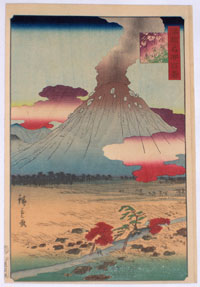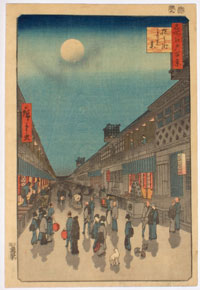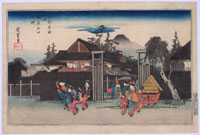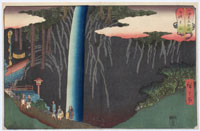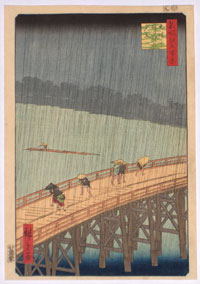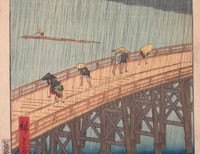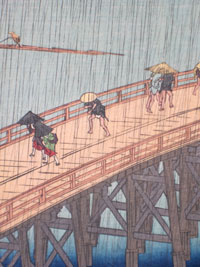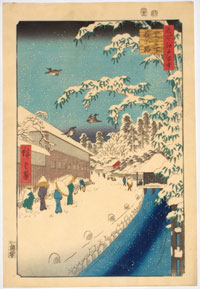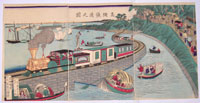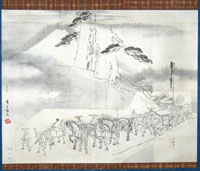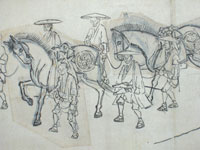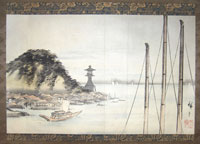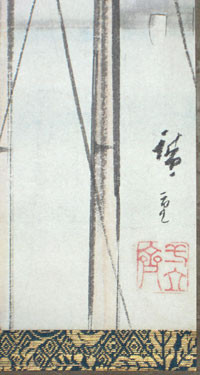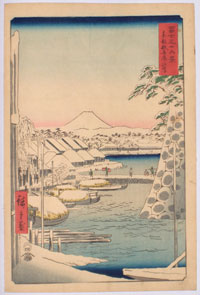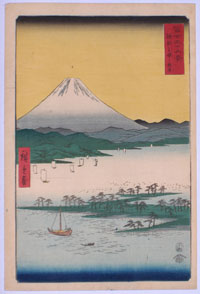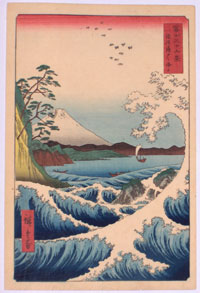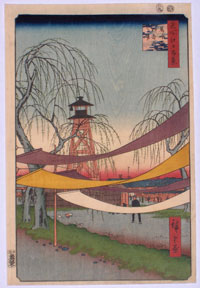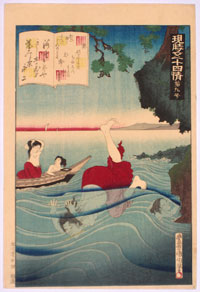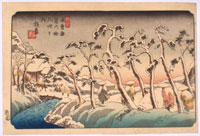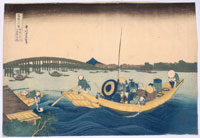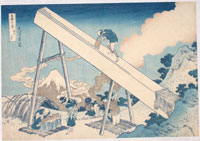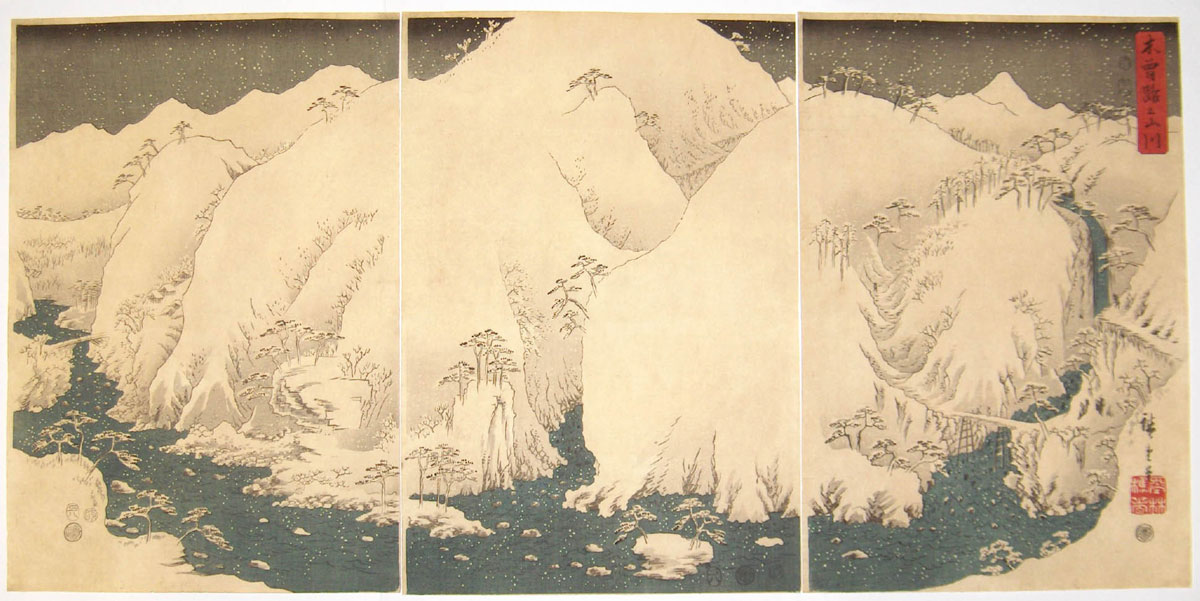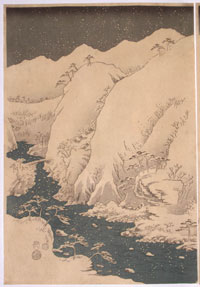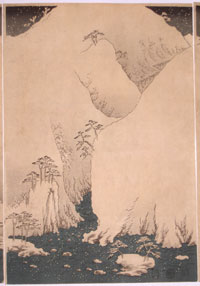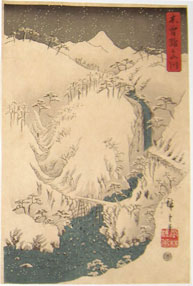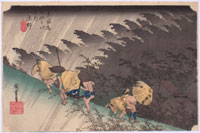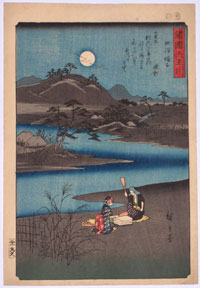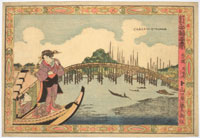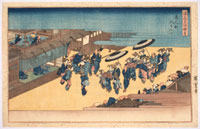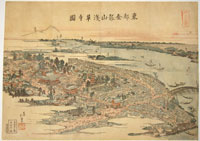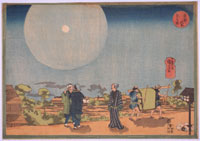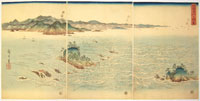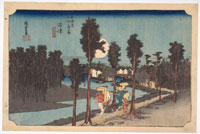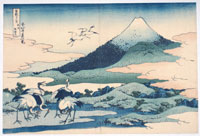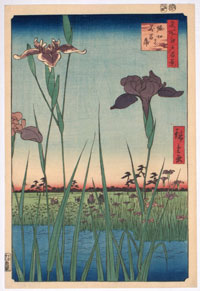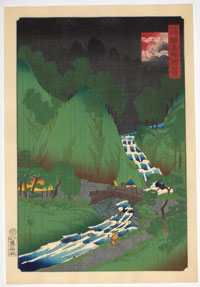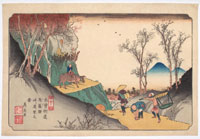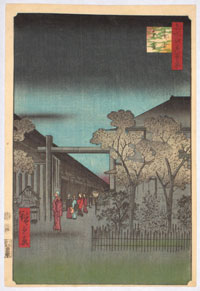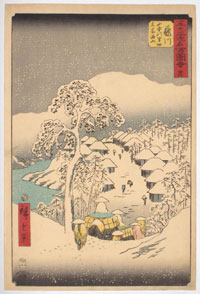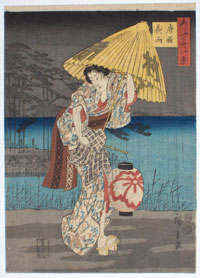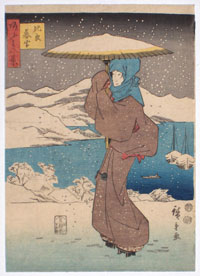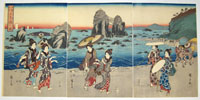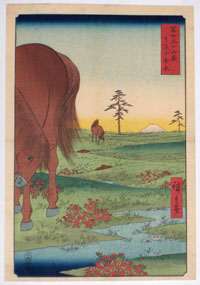/category/landscapes/page/11/
Ichiyusai HIROSHIGE II (1829-1869)
Click here to view image full size.
A view of a smoking Mt Asama, Shinano Province, from Shokoku meisho hyakkei. The “One Hundred Views of Famous Places in the Provinces.” The volcano erupted spectacularly in 1783 and emitted rocks in 1894 and 1900. Published by Uoei, Sheep 9 ( 1859 ).
Superb impression of the first edition with extensive mica and beautiful bokashi. Perfect colour. Light album backing, otherwise fine condition. Signed Hiroshige ga.
Status: Sold
Ichiryusai HIROSHIGE (1797-1858)
Click here to view image full size.
Saruwakacho yoru no kei, “Night View of Saruwaka ( Monkey ) Theatre Street ” from The Hundred Views of Edo published Dragon 9, 1856, by Uoya Eikichi. One of the best prints from the set and a striking design with its deep perspective and shadows. The avenue was where Edo’s kabuki and puppet theatres were rebuilt after a fire in 1841. There were also tea-houses and restaurants. Various editions exist of this print and the easiest way of identifying them is by the block used for the evening sky: The earliest state has a distinctive woodgrain ( see this website also Kobijutsu, Special Issue, Hiroshige, March 1983, no. 414 ). The second state ( as here ) also has a distinctive, but different, woodgrain pattern, while the third and later states lack any prominent woodgrain in the sky ( see Hiroshige, Matthi Forrer, 1997, no. 98 ). The moon is also placed differently on first and subsequent editions together with other small changes in the lanterns and lights.
Fine, early edition with nice bokashi against the moon. Very good colour and condition. This state has sumi graded at the end of the street and emphasised shadows which gives a different feel from the first state. One’s preference is subjective. Signed Hiroshige ga.
Status: Sold
Ichiryusai HIROSHIGE (1797-1858)
Click here to view image full size.
Shimabara deguchi no yanagi, “The Willow at the Gate of Shimabara” from the set of ten prints: Kyoto meisho no uchi, “Famous Places of Kyoto.” Published c 1834 by Eisendo. Shows the entrance to the walled brothel district of Kyoto with a night reveller being helped home. A courtesan with her attendants on the right. This is the rare first edition from this fine set with Eisendo’s blue seal and a blue kiwame seal in right margin. The second has just the kiwame seal, and the third has no seals.
Fine impression. Imperceptible centre fold. Fine colour and condition. Signed Hiroshige ga.
Status: Sold
Ichiryusai HIROSHIGE (1797-1858)
Click here to view image full size.
Oyama, Roben no taki from Sankai mitate sumo, “Mountains and Sea Contending Like Wrestlers.” The set of twenty prints – ten of mountains and ten of harbours – has the title in an umpire’s fan used for wrestling matches. The Roben Waterfall was very popular with pilgrims visiting the shrine in summer. How popular can be judged by looking at Kuniyoshi’s triptych of this subject ( see Kuniyoshi, Juzo Suzuki, 1992, plate 12 ). This design is the second best, after the snow scene, from the set. The first edition with variegated cartouche. Published Horse 7 and 8, 1858 by Yamadaya.
Fine impression and colour. Imperceptible centre fold, otherwise very good condition. Signed Hiroshige ga.
Status: Sold
Ichiryusai HIROSHIGE (1797-1858)
Click here to view image full size.
Ohashi, Atake no yudachi, ” Ohashi, Sudden Shower at Atake” from Edo hyakkei, “One Hundred Views of Edo.” A lovely example of this design which, apart from the Great Wave, is probably the best known Japanese print, and because of this, examples come onto the market often heavily revamped and/or restored and/or very late editions. It was copied by Van Gogh in oils, 1888 ( see Catalogue of the Van Gogh Museum’s collection of Japanese prints, no. 91, p. 99 ). Published Snake Year ( Ansei IV/9 ), October 1857 by Uoya Eikichi. Provenance: Sold by me in 1980.
Not first edition but a careful early impression, with the pillars of the bridge overprinted with light yellow to contrast with the grey of the struts. Numerous states exist of this design and they are well documented. ( Interestingly, the supposed earliest state [ with the silhouettes of two boats on far shore ] has an unattractive colour and gradation scheme – reminiscent of the later editions. This was quickly corrected. ) Fine colour. Slight discolouration in right margin, otherwise fine condition; full size. Signed Hiroshige ga.
Status: Sold
Ichiryusai HIROSHIGE (1797-1858)
Click here to view image full size.
Atago shita Yabukoji, “Bamboo Lane below Atago Hill” from Meisho Edo hyakkei, the “One Hundred Views of Edo” published by Uoei between 1856 and 1858 ( this being 1857 ). A well known snow scene from the set.
Very good impression and condition. Fine colour. Totally untrimmed margins. Signed Hiroshige ga.
Status: Sold
Ichiryusai HIROSHIGE (1797-1858)
Click here to view image full size.
An excessively rare triptych: Onkyoku sekai awase, “Matching the World and Music,” showing 13 dramatic illustrations of the Joruri world ( these being the famous narrated stories ). All episodes are shown against a snowy backdrop. Published 1849-50 by Ibasen.
Fine impression and colour. Some nice oxidation at bottom and very minor soil. Very good condition. Signed Hiroshige giga, “drawn to amuse.”
Status: Sold
Tsukioka YOSHITOSHI (1832-1892) and Yamazaki TOSHINOBU (1857-1886)
Click here to view image full size.
Takanawa tetsudo no zu, “A Picture of the Takanawa Railway.” The train is shown on an embankment in Shinagawa Bay ( approx. 4.5 miles from Nihonbashi ). There was government opposition at the time to building the railway on the shore, hence the reclaimed land that forms the embankment. In fact the train is copied from an engraving in the Illustrated London News published in 1855 where it is described as being owned by the Panama railway for transporting letters and money. The inscription on the side of the second carriage on the engraving reads: U.S. MAIL’S which becomes: US MAUS on the triptych. Published by Maruya Jinpachi 1871. This is the first edition: It was reissued ( probably many times ) with crude colouring and the inscription in far left cartouche removed.
Fine impression and colour. Very good condition. Completely untrimmed. Signed Ikkaisai Yoshitoshi zu, johitsu ( “with the help of” ) Toshinobu.
Status: Sold
Ichiryusai HIROSHIGE (1797-1858)
Click here to view image full size.
An important preliminary sketch ( cartoon ) for a painting ( the finished version of which exists in Japan ). Shows a Daimyo’s procession through a pine grove at Totsuka on the Tokaido with Mount Fuji behind the trees. Totsuka – today part of Yokohama – was the point at which travellers spent their first night, presuming that they had made an early start in Edo. Extensive pentimenti. Sumi on paper. Image size: 41.1 x 52.7 cms; 16.5 x 20.75 inches. Mounted as a scroll with box. Good condition. Spurious signature copied from the finished version, but a genuine painting.
Status: Sold
Ichiryusai HIROSHIGE (1797-1858)
Click here to view image full size.
An important original painting by Hiroshige showing the lighthouse at Tempozan ( Osaka ) and the Yodo River. Ships’ masts in the foreground. Tempozan ( Mount Tempo, Osaka – named after the era name ) was constructed in 1832 to prevent silting of the river mouth. Hiroshige paintings are now rare. Possibly originally one of a set from a makemono. Sumi and colour on paper. Image size: 32.4 x 51.4 cms; 12.75 x 20.25 inches. Mounted as a scroll with box.. Good condition. Signed Hiroshige ga with Ichiryusai seal.
Status: Sold
Ichiryusai HIROSHIGE (1797-1858)
Click here to view image full size.
A snow scene entitled Toto sukiyagashi, “The Sukiya Bank of the Moat of Edo Castle in the Eastern Capital” from the set Fuji sanjurokkei, the “Thirty-six Views of Mount Fuji.” One of the six best designs from the set. Published by Tsutaya Kichizo, 1858.
Very good impression, colour and condition. Signed Hiroshige ga.
Status: Sold
Ichiryusai HIROSHIGE (1797-1858)
Click here to view image full size.
The pine beach at Miho in Suruga Province, Suruga Miho no matsubara from the set Fuji sanjurokkei, the “Thirty-six Views of Mount Fuji.” One of the six best designs from the set. Published by Tsutaya Kichizo, 1858.
Very good impression, colour and condition. Signed Hiroshige ga.
Status: Sold
Ichiryusai HIROSHIGE (1797-1858)
Click here to view image full size.
A giant wave thrown up by the sea at Satta. Suruga Satta kaijo, “Waves off the Satta Pass in Suruga Province” from the set Fuji sanjurokkei, the “Thirty-six Views of Mount Fuji.” The finest design from the set. The spume of a wave was thought to transmogrify into chidori ( a species of plover ) which can be seen here flying above the sea. Published by Tsutaya Kichizo, 1858.
Very good impression, colour and condition. Signed Hiroshige ga.
Status: Sold
Ichiryusai HIROSHIGE (1797-1858)
Click here to view image full size.
Bakuro-cho Hatsune no baba, “The Hatsune Riding Grounds at Bakuro-cho.” In the foreground are bolts of drying cloth with a fire watch-tower in the near distance. From Edo hyakkei, the “One Hundred Views of Edo” published by Uoei between 1856 and 1858 ( this being 1857 ).
Very fine impression of the first edition. Fine colour. Minor creases in left margin, otherwise very good condition. Signed Hiroshige ga.
Status: Sold
Toyohara KUNICHIKA (1835-1900)
Click here to view image full size.
Aoi, Chapter 9, from Genji goju-shi jo, a parody series of the tale of Genji ( ie the 54 Chapters of Genji Monogatari, a 10th century romance by Murasaki-Shikibu. ) Shows ama, female divers, collecting awabi, “abalone”, on the coast of Ise. This is the best design from the set and was a popular subject with ukiyo-e artists as the women were considered quite risqué for obvious reasons. Published by Takekawa Seikichi, Meiji 17 ( 1884 ).
Fine impression, colour and condition. Signed Toyohara Kunichika fude.
Status: Sold
Keisai EISEN (1790-1848)
Click here to view image full size.
Itahana from the Sixty-nine Stations of the Kisikaido. The set was started by Eisen and published by Hoeido in 1835, but in 1837 Hiroshige took over and completed the series with the publisher Iseiri ( Kinjudo ). Shows the entrance to the village with well-wrapped travelers trudging through the snow along a road edged with pines. The sun has set on the horizon. The rare first edition: Other designs from the set are signed on the first edition, but this is the exception. In later editions the red seal, top left, changes; the water in the stream, left, is graded above, not below; the hand-stamped kiwame/Take seal in left margin is left off, and the blue printed on the first figure’s legs and the legs of the two small figures on the bridge is lacking. ( See Ukiyoe Taikei, vol.15, no.15 for an example of the later edition. )
Very fine impression and colour. Two small thin areas right margin and several backed pin holes near border, otherwise fine condition. Unsigned.
Status: Sold
Katsushika HOKUSAI (1760-1849)
Click here to view image full size.
Ommayagashi yori Ryogoku-bashi no sekiyo wo miru, “Viewing Sunset over Ryogoku Bridge from the Ommaya Embankment [ Edo ].” From Hokusai’s most famous series: Fugaku sanju-rokkei, the “Thirty-six Views of Mount Fuji.” The set of 46 prints published by Eijudo, c. 1830 – 32. This was one of a number of ferry crossings between the Sumida bridges. A beautiful design from the set that does not come onto the market as often as others.
Fine impression and colour ( blue outline ). Very full size on three sides. Slightly unevenly trimmed following the block edge on the right. Minor soil and imperceptible centre fold. Signed Zen Hokusai Iitsu hitsu.
Status: Sold
Katsushika HOKUSAI (1760-1849)
Click here to view image full size.
Totomi sanchu, “In the Mountains of Totomi Province.” The location was in what is now the western part of Shizuoka Prefecture and shows a poor logging family, two of whom are sawing planks from a huge log supported by wood trestles. To the left another man is sharpening a saw. Smoke curles up from a fire and clouds encircle Fuji. One of the finest designs from Hokusai’s most famous series: Fugaku sanju-rokkei, the “Thirty-six Views of Mount Fuji.” The set of 46 prints published by Eijudo c. 1830-32. An exceptional example of this design, printed, apart from light brown bokashi to the edge of the smoke cloud, in aizuri, Prussian blue ( Japanese: berorin, ie “Berlin” blue, from the place of manufacture ). The publisher of the set Eijudo advertised the set as using aizuri technique, to cater for the public’s craving for anything new ( it was only widely imported from c. 1829 ), and some designs from the set are predominantly blue while other prints, as here, are mainly aizuri in early editions.
Very fine impression with strong wood grain evident. Probably first edition. The publisher’s seal and censor seal blind-printed bottom left corner, possibly so the red did not interfere with the colour scheme. Other, later editions have the seals in red. Still later the seals are removed, the outline is printed in black – not blue, and the colour scheme is changed dramatically. Fine colour. Slight lateral trimming, mainly on right, otherwise fine condition. Signed Zen Hokusai Iitsu hitsu.
Status: Sold
Ichiryusai HIROSHIGE (1797-1858)
Click here to view image full size.
Mountains and Rivers on the Kiso Road, Kisoji no yamakawa. A majestic snow scene showing a rugged part of the Kisokaido Road. One of the oldest in Japan, becoming less important after the Tokaido Road was constructed, which was faster and easier. Although no series title this is from a trinity of designs depicting Snow ( as here ), Moon and Flowers. These were the last three great prints Hiroshige designed. All are rare, especially Snow and Moon. Published 1857 by Okasawaya Taheiji.
Fine impression and colour. Slight yellowing of paper, otherwise fine condition. Completely untrimmed, matching sheets with extra paper all round. These prints are extremely difficult to find without trimming, often well into the cartouche. Signed Hiroshige hitsu.
Status: Sold
Ichiryusai HIROSHIGE (1797-1858)
Click here to view image full size.
Fujikawa from the so-called “Upright Tokaido.” One of the two snow scenes from the set. Published by Tsutaya Hare 7, 1855.
Very good impression and colour. ( Later editions have a dark sky. ) Margins trimmed somewhat, otherwise very good condition. Signed Hiroshige ga.
Status: Sold
Ichiryusai HIROSHIGE (1797-1858)
Click here to view image full size.
A design that hardly needs cataloguing as it is one of Hiroshige’s most famous. Shono – Sudden Rain, Shono-hakuu from The Fifty-three Stations of the Tokaido Road, published by Hoeido, c. 1831-4. Some travellers are caught in a downpour near the town of Shono in Ise Province. Various changes were tried by the printers over a period of time: Altering the pigments and bokashi to achieve different atmospheric effects. This impression tallies mostly with 17(b) in Hiroshige, The Ukiyo-e Society of America, 1983 which gives states (a) to (e).
Good to very good impression and colour. Trimmed close but retaining black border. Signed Hiroshige ga.
Status: Sold
Ichiryusai HIROSHIGE (1797-1858)
Click here to view image full size.
The Kinuta ( or Toi ) River in Settsu Province from the vertical Shokoku Mu Tama-gawa, the “Six Tama [ Crystal ] Rivers of Various Provinces.” ( So-called because these streams were noted for the purity of their water. ) Published by Marukyo, 11/1857. Shows two girls fulling cloth beneath a full moon. ( Toi is also the word for beating cloth. ) See the Shunman on this website in Beauties for another print of the same subject. The best design from the set and a beautiful composition.
Fine impression and colour. Some minimal soil in margins, otherwise fine condition. Signed Hiroshige ga.
Status: Sold
Kochoro KUNISADA (1786-1865)
Click here to view image full size.
The Eitai Bridge ( Eitaibashi ) from a second series of five prints with title: Komo abura-e fu, “Drawings in the Red Hair [ Dutch ] Oil Painting Style.” Shows beauties in a pleasure boat in the foreground with a view along the Sumida of Eitai Bridge and Tsukuda Island. A mass of masts is shown in the harbour. ( At this time – c. 1825 – pure spring water and mountain streams supplied the canals and rivers with drinking water and the mouth of the Sumida was abundant with sea and fresh water fish. A distinct difference from today. ) This extremely rare set mimics Dutch leather with the borders and European writing with horizontal calligraphy. Published c. 1825 by Kinkodo.
Very good impression with extremely well retained colour. Minor soil, otherwise very good condition. Signed Konomi ni makase Kunisada egaku, “Drawn by request by Kunisada.”
Status: Sold
Ichiyusai HIROSHIGE II (1829-1869)
Click here to view image full size.
Heavy rain and wind at Tatsuguchi in Bizen Province from Shokoku meisho hyakkei, the “One Hundred Views of Famous Places in the Provinces.” Published by Uoei, Monkey 2 ( 1860 ).
Very good impression, colour and condition. Signed Hiroshige ga.
Status: Sold
Ichiryusai HIROSHIGE (1797-1858)
Click here to view image full size.
Shinmachi kukencho from Naniwa [ Osaka ] meisho zu, “Famous Views of Naniwa.” Shows parading courtesans in the licensed quarter. A set of ten prints published 1834 by Eisendo. Rare.
Fine impression. Very good colour and condition. Signed Hiroshige ga ( on the patterned border which is often trimmed off on this design ).
Status: Sold
Aoigaoka HOKKEI (1780-1850)
Click here to view image full size.
A large ( 17.25 x 24.25 inches; 44 x 62 cms. ) aerial view of the Asakusa Kinryu Shrine in the Eastern Capital, Toto Kinryuzan, Asakusa dera no zu. Published c.1830s by Izumiya Ichibei and Mamura Hanbei and blocks cut by Akibara Namijiro. At the top right a red seal ( of a collector or shop ) Ei-o do. There appears to be another edition of this view with another publisher, lacking block cutter’s name and without the setting sun top right. Rare: For obvious reasons these large views did not survive in any quantity.
Very good impression and colour. Faint fold marks with some expert restoration. Lightly laid onto Japanese paper. Signed Aoigaoka Hokkei sha.
Status: Sold
Utagawa KUNIYOSHI (1797-1861)
Click here to view image full size.
Shin Yoshiwara from the set of ten prints: Toto meisho, “Famous Views of the Eastern Capital.” Shows night revellers beneath a moon with an enormous halo. A much admired print with a westernised chiaroscuro effect. Excessively rare. Published by Kagaya Kichibei, c 1834.
Fine impression. Extremely well retained colour. Restored top edge running from the centre towards right corner and top left corner. Signed Ichiyusai Kuniyoshi ga.
Status: Sold
Ichiryusai HIROSHIGE (1797-1858)
Click here to view image full size.
A view over the Naruto Strait of the whirlpools at Awa, Awa no naruto no fukei. Although no series title this is from a trinity of triptychs depicting Snow, Moon and Flowers, this being the last ( because the eddies and whirls were reminiscent of flowers [ nami no hana, “flowers of the waves” ] ). These were the last three great prints Hiroshige designed. All are rare, especially Snow and Moon. Published 1857 by Okasawaya Taheiji.
Very good impression. It is claimed that the first printings have a sliver of land on the far right horizon which is removed on later editions. However, there seems to be no discernable difference in quality between that state and very good impressions without. So, if true, this must have happened early on. Almost all impressions are without. Indeed, late impressions of this set of three triptychs are not known. Very good colour. Expertly repaired wormhole on centre sheet. Virtually untrimmed: These prints are extremely difficult to find without trimming, often well into the title cartouche. Signed Hiroshige ga.
Status: Sold
Ichiryusai HIROSHIGE (1797-1858)
Click here to view image full size.
Station 13, Numazu, hikure, “Yellow Dusk” from the Fifty-three Stations of the Tokaido. The set published by Hoeido and Senkakudo in 1834. One of the finest designs from the set showing travellers about to enter the village of Numazu beneath the huge orb of the moon. On each side are dark pines, and this station is famous for its forest which stretches along the seashore. One of the travellers is carrying a red tengu mask on his back, the mark of a pilgrim to the Shinto Shrine of Kompira.
Very good impression and colour. Several small expertly restored wormholes in left margin, otherwise good condition. This design is often coarsely printed – possibly the blocks were softer than normal. Signed Hiroshige ga.
Status: Sold
Katsushika HOKUSAI (1760-1849)
Click here to view image full size.
Umezawa Marsh, Sagami Province. The location appears to be present-day Ninomiya, a city near the coast of Kanagawa Prefecture between Kozu and Odawara. Shows a group of cranes in the foreground with two others flying off towards Fuji. From Hokusai’s most famous series: Fugaku sanju-rokkei, the “Thirty-six Views of Mount Fuji.” The set of 46 prints published by Eijudo c 1830-32. This is one of the most admired designs from the set and one of the most difficult to find in early state ( like Kajikazawa ). Why this should be is not known: Perhaps they were popular at the time and the blocks wore quickly or softer wood was used. Alternatively, these also tend to be the designs that are printed almost solely in tones of blue and green, and they may have been the first to be designed to show off the new Prussian blue.
Fine, early impression with perfect colour and very full size. Slight centre fold, otherwise fine condition. Signed Zen Hokusai Iitsu hitsu.
Status: Sold
Ichiryusai HIROSHIGE (1797-1858)
Click here to view image full size.
Horikiri no hana shobu, “Flowering Irises at Horikiri” from Meisho Edo hyakkei, the “One Hundred Views of Edo” published by Uoei between 1856 and 1858 ( this being 1857 ). The village of Horikiri, situated up the Sumida River from Edo, was famous for growing irises, azaleas, morning glory and chrysanthemums. Large foreground images, such as the blooms here, was a popular compositional device used by Hiroshige and impressed and was picked-up by many French artists of the late 19th century. One of Hiroshige’s most popular prints.
Very good impression with strong woodgrain still evident in the sky and right iris. Fine colour and condition. Signed Hiroshige ga.
Status: Sold
Ichiyusai HIROSHIGE II (1826-1869)
Click here to view image full size.
Ochiai Bridge in heavy rain, Mino Province from an uncompleted set: Shokoku meisho hyakkei, “One Hundred Views of the Provinces.” Published by Uoei between 1859 – 1861 ( this being 1861 ). One of the best prints from a set with many mediocre designs. An evening rain scene showing travellers crossing a fast-flowing torrent.
Superb impression of the first edition with mica at top. Superb colour and condition. Signed Hiroshige ga.
Status: Sold
Ichiyusai HIROSHIGE II (1826-1869)
Click here to view image full size.
Suo Iwakuni Kintaibashi, “The Bridge of the Brocade Sash at Iwakuni in Suo Province.” From an uncompleted set: Shokoku meisho hyakkei, “One Hundred Views of the Provinces.” Published by Uoei between 1859 – 1861 ( this being 1859 ). Shows the beautiful five-arch bridge spanning the Nishiki-gawa under heavy snow. The best print from the set and probably Hiroshige’s masterpiece.
Fine impression of the first edition with extensive mica. Fine colour. Small repaired binding holes right margin and minor marks au verso, otherwise very good condition. Later editions lack variegated cartouche and the colour-banded publisher’s seal in left margin ( see Ukiyo-e Taikei, vol.11, no.64 for the later state ). Signed Hiroshige ga.
Status: Sold
Keisai EISEN (1790-1848)
Click here to view image full size.
Magome from the Sixty-nine Stations of the Kisokaido. The set was started by Eisen and published by Hoeido in 1835, but in 1837 Hiroshige took over and completed the series with the publisher Iseiri ( Kinjudo ).
Fine impression. A rare variant first edition with signature but without the large central mountain. Not listed by Strange. There are later editions without signature and with and without central mountain. Fine colour and condition. Signed Keisai ga.
Status: Sold
Ichiryusai HIROSHIGE (1797-1858)
Click here to view image full size.
Kakuchu Shinonome, “Dawn in the Yoshiwara” from Edo hyakkei, the “One Hundred Views of Edo” published by Uoei between 1856 and 1858 ( this being 1857). One of the best designs from the set.
Fine impression of the first edition. Fine colour and condition. Signed Hiroshige ga.
Status: Sold
Ichiryusai HIROSHIGE (1797-1858)
Click here to view image full size.
Fujikawa from the so-called “Upright Tokaido.” One of the two snow scenes from the set. Published by Tsutaya Hare 7, 1855.
Very good impression and colour. ( Later editions have a dark sky. ) Small corner repair outside image, otherwise very good condition. Signed Hiroshige ga.
Status: Sold
Ichiryusai HIROSHIGE (1797-1858)
Click here to view image full size.
A chuban print showing a young woman on a rainy night. Karasaki from a set of prints: Eight Scenes of Meeting [ Omi ]. On her umbrella are the characters Mura and Ichi – the publisher Muraichi, published c 1847-1848. Extremely rare: I have not catalogued this set before. This appears to be the Suzuki impression, illustrated in his book, no.205, Utagawa Hiroshige, Juzo Suzuki, Tokyo 1970. Another impression in The Art of Hiroshige, Tsuneo Tamba, Tokyo 1965.
Very good impression and colour. Minor soil, otherwise good condition. Signed Hiroshige ga.
Status: Sold
Ichiryusai HIROSHIGE (1797-1858)
Click here to view image full size.
A chuban print showing a young woman walking in the snow. Evening snow at Mount Hira from a set of prints: Eight Scenes of Meeting [ Omi ]. Published by Muraichi, c 1847-1848. Extremely rare: I have not catalogued this set before and cannot, as yet, locate another illustrated example.
Very good impression and colour. Minor soil, otherwise good condition. Signed Hiroshige ga.
Status: Sold
Ichiryusai HIROSHIGE (1797-1858)
Click here to view image full size.
The second triptych from a set Ise Meisho, Futamigaura no zu. Young girls sightseeing on the beach at Futami. In the background are the “Husband and Wife” rocks. The tasseled ropes indicate this is a Shinto site. This area was a popular tourist attraction. Published by Sanoki, 1847-1852. Rare.
Very fine impression. Perfect colour. Very slight trimming, otherwise fine condition. Signed Hiroshige ga.
Status: Sold
Ichiryusai HIROSHIGE (1797-1858)
Click here to view image full size.
Koganegahara, Shimosa Province from the set Fuji sanjurokkei, the “Thirty-six Views of Mount Fuji.” One of the most popular designs from the set. Shows horses in a flower-strewn meadow with a brook and a distant view of Fuji. Published by Tsutaya Kichizo, 1858.
Extremely fine impression ( probably first edition ). Fine colour. Slight centre fold, invisible at front apart from margins, otherwise fine condition. Signed Hiroshige ga.
Status: Sold
